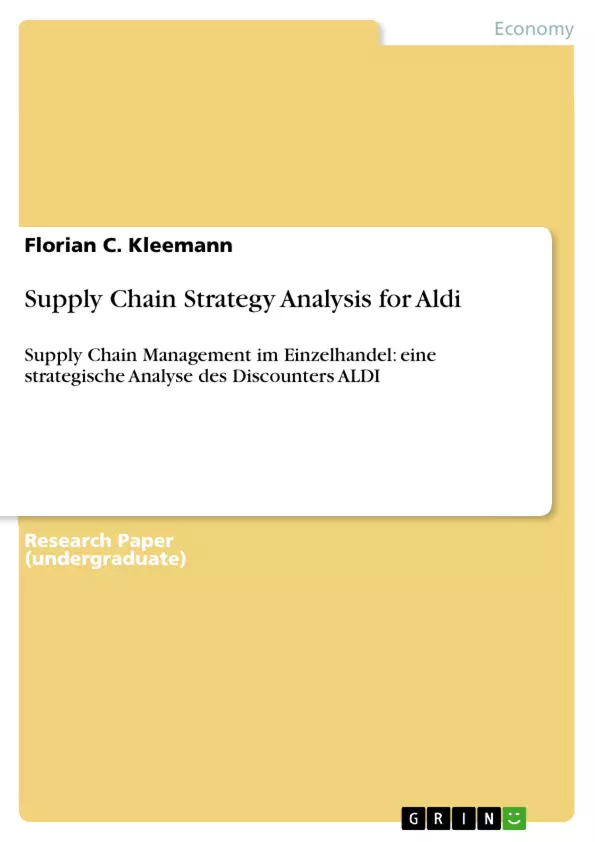Für kaum einen Wirtschaftszweig ist ein erfolgreiches Management der Lieferkette so wichtig wie den Lebensmitteleinzelhandel. An ständige Verfügbarkeit gewöhnte Kunden bei gleichzeitig überwiegend schnellverderblichen Waren und konkurrenzbedingt geringe Margen erfordern eine gut abgestimmte, friktionslose und agile Supply Chain. Die Arbeit entwickelt ein konzeptionelles Modell einer solchen Lieferkette für das Unternehmen Aldi Süd mit Fokus auf schnell verderbliche Lebensmittel. Auf dieser Grundlage wird die Supply Chain-Strategie des als besonders effizient geltenden Discounters untersucht; insbesondere erfolgt eine kritische Analyse möglicher Defizite der Aldi-Lieferkette gegenüber „Best Practices“ aus dem Supply Chain Management - auf strategischer Ebene, wie z.B. dem Lieferantenmanagement ebenso wie bei Transportlogistik, Verpackung oder In-Store-Logistik. Daraus wird dann eine Soll-Lieferkette skizziert sowie Handlungsempfehlungen zur Umsetzung gegeben.
Table of Contents
- 1. Introduction
- 2. An "As Is" map of Aldi's supply chain for dairy products
- 3. Improving Aldi's supply chain management
- 4. Conclusion
Objectives and Key Themes
This report analyzes Aldi Süd's supply chain strategy, focusing on perishable goods. It aims to identify potential weaknesses in Aldi's approach compared to best practices in supply chain management (SCM), and to propose improvements. The analysis considers various aspects of the supply chain, from supplier relationships to logistics and in-store operations.
- Analysis of Aldi Süd's current supply chain for perishable goods.
- Comparison of Aldi's strategy with best practices in SCM.
- Identification of potential weaknesses in Aldi's supply chain strategy.
- Development of recommendations for improving Aldi's supply chain.
- Creation of a "To-Be" model for an improved Aldi supply chain.
Chapter Summaries
1. Introduction: This introductory chapter sets the stage for the report by highlighting the importance of supply chain management (SCM) in the grocery retail industry, particularly for perishable goods. It introduces Aldi Süd as a case study, emphasizing its cost-focused strategy and recent slowdown in growth. The chapter outlines the report's structure, explaining the planned analysis of Aldi's current supply chain ("As-Is"), a comparison with SCM best practices, and the development of a proposed improved model ("To-Be"). The chapter also clarifies the understanding of SCM used throughout the report and defines the term "discounter" in the context of the grocery retail industry.
2. An "As Is" map of Aldi's supply chain for dairy products: This chapter would detail Aldi's existing supply chain processes for dairy products, mapping the flow of goods from suppliers to consumers. It likely analyzes the different stages involved, highlighting the company's focus on cost efficiency and its various logistical and operational aspects. This could include specifics on supplier relationships, transportation, storage, and in-store handling of dairy products. The chapter would provide a comprehensive picture of Aldi's current practices and serve as a baseline for later comparative analysis and improvement suggestions.
3. Improving Aldi's supply chain management: This chapter would analyze the findings from the "As-Is" assessment, comparing Aldi's practices against established best practices in SCM. It would identify areas for improvement and suggest concrete strategies to enhance Aldi's supply chain efficiency and effectiveness. This could involve recommendations on technology adoption, supplier relationships, logistics optimization, and in-store processes. The chapter would likely propose a revised "To-Be" model for Aldi's supply chain, incorporating the suggested improvements and outlining the expected benefits.
Keywords
Supply Chain Management, Cold Chain, Grocery Retail, Supply Chain Strategy, Aldi, Discount, Retail, Cost Leadership, Supplier Relationships, Logistics, Inventory Management, Information Technology, ECR, RFID, EDI, On-Shelf Availability.
Aldi Süd Dairy Supply Chain Analysis: Frequently Asked Questions
What is the main focus of this report?
This report analyzes Aldi Süd's supply chain strategy for perishable goods, specifically dairy products. It aims to identify weaknesses in Aldi's current approach and propose improvements based on best practices in supply chain management (SCM).
What are the key objectives of the report?
The report's objectives include analyzing Aldi Süd's current supply chain, comparing it to SCM best practices, identifying weaknesses, developing improvement recommendations, and creating a "To-Be" model for an optimized supply chain.
What aspects of Aldi's supply chain are analyzed?
The analysis considers various aspects, including supplier relationships, transportation, storage, in-store operations, and the overall flow of goods from supplier to consumer. The report specifically focuses on the "cold chain" aspects crucial for perishable goods.
How does the report structure its analysis?
The report uses a structured approach. It begins with an "As-Is" analysis of the current state of Aldi's dairy supply chain, then compares this to industry best practices, identifies areas needing improvement, and finally proposes a "To-Be" model illustrating the recommended improvements.
What kind of improvements are suggested in the report?
The report suggests potential improvements across various areas. These likely include recommendations on technology adoption (e.g., RFID, EDI), optimized logistics, enhanced supplier relationships, and streamlined in-store processes to improve efficiency and on-shelf availability.
What is the scope of the "As-Is" analysis?
The "As-Is" analysis provides a detailed map of Aldi's existing supply chain processes for dairy products. This includes examining all stages, from sourcing raw materials to delivering products to Aldi stores and ultimately the consumer.
What is the significance of the "To-Be" model?
The "To-Be" model represents a proposed improved version of Aldi's dairy supply chain, incorporating the recommendations from the analysis. It showcases the potential benefits of implementing the suggested changes.
What keywords are associated with this report?
Key terms include Supply Chain Management, Cold Chain, Grocery Retail, Supply Chain Strategy, Aldi, Discount, Retail, Cost Leadership, Supplier Relationships, Logistics, Inventory Management, Information Technology, ECR, RFID, EDI, and On-Shelf Availability.
What is the overall conclusion of the report (in brief)?
While the detailed conclusion isn't explicitly provided in the preview, the report aims to provide actionable recommendations to enhance Aldi Süd's efficiency and competitiveness in the dairy supply chain by addressing identified weaknesses and leveraging best practices.
What is the target audience for this report?
The target audience is likely academics and professionals in the field of supply chain management and grocery retail, potentially those interested in Aldi's business strategy and operations.
- Citar trabajo
- Florian C. Kleemann (Autor), 2011, Supply Chain Strategy Analysis for Aldi, Múnich, GRIN Verlag, https://www.grin.com/document/190106



